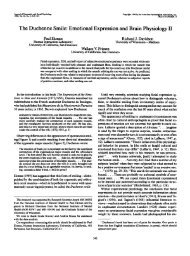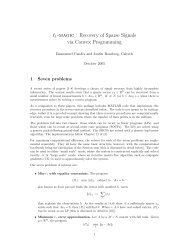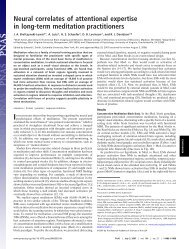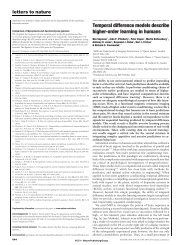Deconvolution Analysis of FMRI Time Series Data - Waisman ...
Deconvolution Analysis of FMRI Time Series Data - Waisman ...
Deconvolution Analysis of FMRI Time Series Data - Waisman ...
Create successful ePaper yourself
Turn your PDF publications into a flip-book with our unique Google optimized e-Paper software.
t = b 0 b 1 h[0] h[1] h[2] h[3] h[4]= 100:00 1:00 0:00 5:00 10:00 5:00 2:00which is not surprising, since no noise was present in the \measurement".Example 1.4.2.2 Estimation <strong>of</strong> IRF from Non-Overlapping Responses AdditiveNoiseTo simulate the eect <strong>of</strong> measurement error, add white Gaussian noise to the abovedata. For example, adding values from a table <strong>of</strong> N( 2 ) = N(0 4) random variates(from Ref.[3]) to the above z(t), we obtain:zn(t) =z(t)+"(t)= f 99:78 100:46 101:30 113:51 111:60 109:01 107:84 106:42 106:11 114:85117:55 113:18 114:58 111:93 115:01 121:21 128:23 125:22 123:75 120:28 gSave your \response+noise" data into le zn.1D. You can plot the \data" using the command:1dplot zn.1D. Looking at the plot, can you visualize the shape <strong>of</strong> the IRF?Now, execute the script from the previous Example, except replace -input1D z.1D with-input1D zn.1D. The program output is as shown below:Program 3dDeconvolve Screen Output for Example 1.4.2.2Program:3dDeconvolveAuthor:B. Douglas WardInitial Release: 02 Sept 1998Latest Revision: 27 July 2000Baseline:t^0 coef = 95.9670 t^0 t-st = 69.1079t^1 coef = 1.3007 t^1 t-st = 15.5897Stimulus: fh[0] coef = 0.2848 h[0] t-st = 0.2062h[1] coef = 6.4541 h[1] t-st = 4.6989h[2] coef = 10.1522 h[2] t-st = 8.1118h[3] coef = 5.5282 h[3] t-st = 4.4670h[4] coef = 3.8141 h[4] t-st = 3.1032R^2 = 0.9075 F[5,9] = 17.6576 p-value = 2.0485e-04Full Model:MSE = 2.2556R^2 = 0.9075 F[5,9] = 17.6576 p-value = 2.0485e-0431



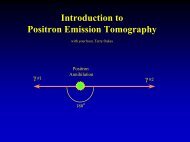
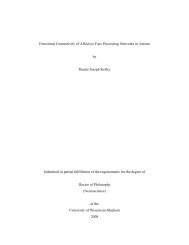
![[F-18]-L-DOPA PET scan shows loss of dopaminergic neurons](https://img.yumpu.com/41721684/1/190x146/f-18-l-dopa-pet-scan-shows-loss-of-dopaminergic-neurons.jpg?quality=85)
